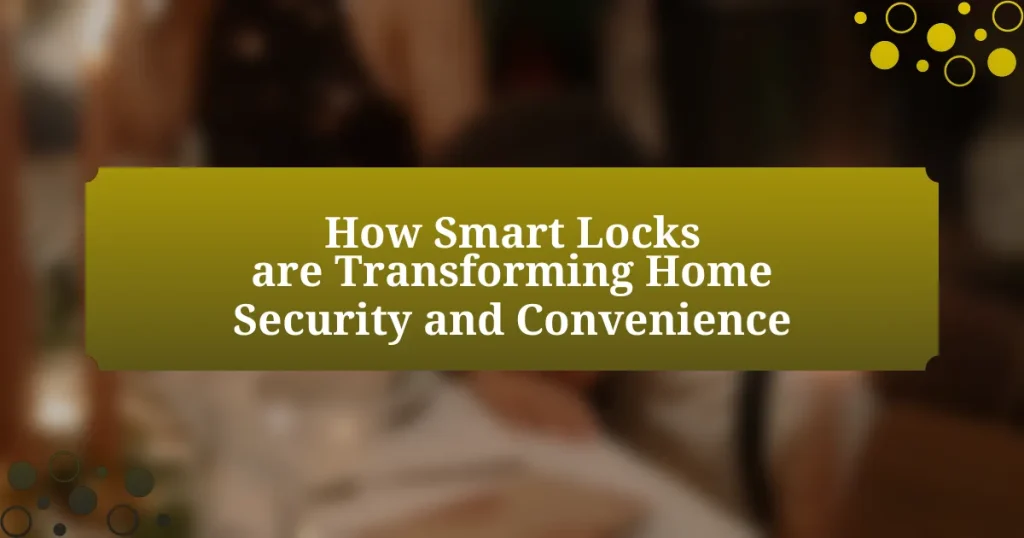Smart thermostats are advanced devices designed to optimize heating and cooling systems, leading to significant energy savings and reduced utility costs. By learning user preferences and schedules, these thermostats can adjust temperatures automatically, resulting in an average savings of 10-15% on heating and cooling expenses. Key features include programmable scheduling, remote access, and real-time energy usage reports, all of which enhance energy efficiency. The article also discusses the technology behind smart thermostats, the importance of energy efficiency for cost savings, potential drawbacks, and practical tips for maximizing savings. Additionally, it highlights available incentives and rebates that can offset initial investment costs, making smart thermostats an attractive option for homeowners seeking to reduce energy consumption and expenses.

How Can Smart Thermostats Help You Save Money?
Smart thermostats help you save money by optimizing your heating and cooling systems based on your usage patterns and preferences. They learn your schedule and adjust the temperature accordingly, reducing energy consumption when you are not home. According to the U.S. Department of Energy, homeowners can save an average of 10-15% on heating and cooling costs by using a programmable thermostat, which smart thermostats enhance with features like remote access and real-time energy usage reports. This data-driven approach allows for more efficient energy management, leading to significant cost savings over time.
What are the key features of smart thermostats?
Smart thermostats offer several key features that enhance energy efficiency and user convenience. These features include programmable scheduling, which allows users to set specific heating and cooling times, optimizing energy use based on occupancy patterns. Additionally, smart thermostats often include remote access via smartphone apps, enabling users to adjust settings from anywhere, thus preventing energy waste when homes are unoccupied.
Another important feature is learning capabilities, where the thermostat adapts to user preferences over time, automatically adjusting temperatures for comfort and efficiency. Many models also provide energy usage reports, giving users insights into their consumption patterns and suggesting ways to save energy. Furthermore, integration with smart home systems allows for seamless operation with other devices, enhancing overall home automation.
These features collectively contribute to significant energy savings, with studies indicating that smart thermostats can reduce heating and cooling costs by up to 10-15%.
How do these features contribute to energy efficiency?
Smart thermostats contribute to energy efficiency by optimizing heating and cooling schedules based on user behavior and environmental conditions. These devices utilize algorithms to learn patterns, allowing them to adjust temperatures automatically when occupants are away or asleep, which reduces unnecessary energy consumption. For instance, studies show that smart thermostats can save homeowners an average of 10-15% on heating and cooling costs annually, translating to significant energy savings. Additionally, features like remote access and integration with smart home systems enable users to monitor and control energy usage in real-time, further enhancing efficiency.
What technology is used in smart thermostats?
Smart thermostats utilize a combination of technologies including Wi-Fi connectivity, machine learning algorithms, and sensors. Wi-Fi connectivity allows users to control the thermostat remotely via smartphone apps, enhancing convenience and energy management. Machine learning algorithms analyze user behavior and preferences to optimize heating and cooling schedules, leading to energy savings. Additionally, sensors monitor temperature, humidity, and occupancy, enabling the thermostat to adjust settings automatically based on real-time conditions. These technologies collectively contribute to the efficiency and cost-saving potential of smart thermostats.
Why is energy efficiency important for cost savings?
Energy efficiency is important for cost savings because it reduces energy consumption, leading to lower utility bills. By implementing energy-efficient practices and technologies, such as smart thermostats, households can decrease their energy use by up to 30%, according to the U.S. Department of Energy. This reduction in energy consumption directly translates to significant financial savings over time, making energy efficiency a crucial factor in managing household expenses.
How does energy consumption impact monthly bills?
Energy consumption directly affects monthly bills by determining the total amount of electricity or gas used, which is multiplied by the utility rate to calculate the final cost. Higher energy consumption leads to increased bills, as utility companies charge based on the kilowatt-hours or therms consumed. For example, according to the U.S. Energy Information Administration, the average residential electricity rate in the U.S. was about 13.31 cents per kilowatt-hour in 2021. Therefore, if a household uses 1,000 kilowatt-hours in a month, the bill would be approximately $133.10. This relationship illustrates how managing energy consumption can significantly influence overall monthly expenses.
What are the long-term financial benefits of reducing energy use?
Reducing energy use leads to significant long-term financial benefits, primarily through lower utility bills and decreased operational costs. For instance, households that implement energy-efficient practices can save an average of 10-50% on their energy bills annually, depending on the measures taken. Additionally, businesses that reduce energy consumption often experience lower overhead costs, which can enhance profitability. According to the U.S. Department of Energy, energy-efficient upgrades can yield a return on investment of 20% or more over time, further validating the financial advantages of energy reduction strategies.

What are the different ways smart thermostats save you money?
Smart thermostats save you money primarily through energy efficiency, automated scheduling, and remote access. By learning your heating and cooling preferences, smart thermostats optimize energy usage, reducing unnecessary consumption. For instance, studies show that smart thermostats can lower energy bills by up to 10-15% annually. Additionally, they allow users to set schedules that align with their routines, ensuring that heating or cooling only occurs when needed. Remote access via smartphone apps enables users to adjust settings on-the-go, preventing energy waste when homes are unoccupied. These features collectively contribute to significant savings on utility bills.
How do smart thermostats optimize heating and cooling schedules?
Smart thermostats optimize heating and cooling schedules by using algorithms that learn user preferences and occupancy patterns. These devices analyze data from sensors and user inputs to adjust temperature settings automatically, ensuring comfort while minimizing energy consumption. For instance, a study by the U.S. Department of Energy found that smart thermostats can save homeowners an average of 10-15% on heating and cooling costs by efficiently managing energy use based on real-time conditions and historical data.
What is the role of learning algorithms in scheduling?
Learning algorithms play a crucial role in scheduling by optimizing the allocation of resources and time based on historical data and user behavior. These algorithms analyze patterns in energy usage and occupancy to create efficient schedules that minimize energy consumption while maintaining comfort. For instance, smart thermostats utilize machine learning to adapt to user preferences and environmental changes, resulting in energy savings of up to 15% according to the U.S. Department of Energy. This data-driven approach enhances the effectiveness of scheduling by ensuring that heating and cooling systems operate only when necessary, thereby reducing costs and improving energy efficiency.
How can remote access contribute to energy savings?
Remote access can contribute to energy savings by allowing users to monitor and control their heating and cooling systems from anywhere, optimizing energy usage based on real-time needs. Smart thermostats equipped with remote access features enable users to adjust settings when away from home, preventing unnecessary energy consumption. For instance, a study by the American Council for an Energy-Efficient Economy found that homes with smart thermostats can save an average of 10-15% on heating and cooling costs annually. This capability to remotely manage energy use leads to more efficient operation of HVAC systems, reducing overall energy expenditure.
What incentives or rebates are available for smart thermostat users?
Smart thermostat users can access various incentives and rebates offered by utility companies and government programs. For instance, many utility providers offer rebates that can range from $50 to $150 for purchasing and installing a smart thermostat, aimed at encouraging energy efficiency. Additionally, federal tax credits may be available for energy-efficient home improvements, including smart thermostats, which can provide up to 10% of the cost back to the homeowner. Programs like Energy Star also promote smart thermostats, often linking users to local incentives. These financial benefits are designed to reduce energy consumption and promote the adoption of energy-saving technologies.
How can these incentives affect the initial investment cost?
Incentives can significantly reduce the initial investment cost of smart thermostats. Financial incentives such as rebates, tax credits, and utility company discounts lower the upfront price, making the technology more accessible. For example, the U.S. Department of Energy reports that various state and local programs offer rebates that can cover up to 50% of the purchase and installation costs of smart thermostats. This reduction in initial costs encourages more homeowners to invest in energy-efficient solutions, ultimately leading to greater energy savings and reduced utility bills over time.
What programs are offered by utility companies?
Utility companies offer various programs aimed at energy efficiency and cost savings, including demand response programs, energy efficiency rebates, and smart thermostat incentives. Demand response programs encourage consumers to reduce or shift their electricity usage during peak periods, often providing financial incentives for participation. Energy efficiency rebates reward customers for upgrading to energy-efficient appliances or systems, which can lead to lower energy bills. Smart thermostat incentives specifically promote the installation of smart thermostats, which can optimize heating and cooling schedules, further reducing energy consumption and costs. These programs are designed to help consumers save money while promoting sustainable energy use.

What are the potential drawbacks of smart thermostats?
Smart thermostats can have several potential drawbacks, including high initial costs, reliance on Wi-Fi, and complexity in setup and use. The initial purchase price of smart thermostats can be significantly higher than traditional models, often ranging from $100 to $300, which may deter some consumers. Additionally, smart thermostats require a stable internet connection to function optimally; if the Wi-Fi goes down, users may lose remote access and automated features. Furthermore, the setup process can be complicated for individuals who are not tech-savvy, leading to frustration and improper installation, which can negate energy-saving benefits.
How can installation costs impact overall savings?
Installation costs can significantly impact overall savings by affecting the initial investment required for smart thermostats. Higher installation costs can lead to a longer payback period, reducing the immediate financial benefits of energy savings. For instance, if a smart thermostat installation costs $300 and saves $100 annually on energy bills, the payback period is three years. Conversely, if installation costs are lower, say $150, the payback period shortens to 1.5 years, making the investment more attractive. Therefore, the relationship between installation costs and savings is crucial in determining the financial viability of adopting smart thermostat technology.
What are the common installation challenges?
Common installation challenges for smart thermostats include compatibility issues with existing HVAC systems, complex wiring configurations, and inadequate Wi-Fi connectivity. Compatibility issues arise when the smart thermostat is not designed to work with certain types of heating and cooling systems, such as older models or those without a C-wire. Complex wiring configurations can lead to confusion during installation, especially for users unfamiliar with electrical systems. Inadequate Wi-Fi connectivity can hinder the thermostat’s functionality, as many smart features rely on a stable internet connection for remote access and control. These challenges can result in improper installation, limiting the potential energy savings and benefits of using smart thermostats.
How do maintenance costs compare to traditional thermostats?
Maintenance costs for smart thermostats are generally lower than those for traditional thermostats. Smart thermostats often require less frequent servicing due to their advanced technology, which can optimize heating and cooling systems more efficiently. For example, a study by the American Council for an Energy-Efficient Economy found that smart thermostats can reduce energy consumption by 10-15%, leading to fewer maintenance issues over time. This efficiency translates to reduced wear and tear on HVAC systems, ultimately lowering overall maintenance costs compared to traditional models.
What are the privacy concerns associated with smart thermostats?
Smart thermostats raise significant privacy concerns primarily due to their data collection practices. These devices often gather detailed information about users’ daily routines, preferences, and home occupancy patterns, which can be sensitive in nature. For instance, data breaches have occurred where personal information from smart devices was exposed, highlighting vulnerabilities in their security protocols. Additionally, companies may share this data with third parties for marketing purposes, further compromising user privacy. According to a 2020 report by the Electronic Frontier Foundation, many smart home devices, including thermostats, lack robust privacy protections, making users susceptible to unauthorized access and surveillance.
How can users protect their data while using smart thermostats?
Users can protect their data while using smart thermostats by implementing strong security measures such as changing default passwords, enabling two-factor authentication, and regularly updating the device’s firmware. Changing default passwords reduces the risk of unauthorized access, as many devices come with easily guessable credentials. Enabling two-factor authentication adds an extra layer of security, making it harder for intruders to gain access even if they have the password. Regular firmware updates are crucial because they often include security patches that address vulnerabilities, thereby protecting user data from potential breaches.
What measures do manufacturers take to ensure user privacy?
Manufacturers implement several measures to ensure user privacy, including data encryption, anonymization, and strict access controls. Data encryption protects user information during transmission and storage, making it unreadable to unauthorized parties. Anonymization techniques are used to remove personally identifiable information from data sets, ensuring that individual users cannot be traced. Additionally, manufacturers enforce strict access controls, limiting data access to authorized personnel only, which reduces the risk of data breaches. These practices are essential for maintaining user trust and complying with privacy regulations such as the General Data Protection Regulation (GDPR).
What practical tips can help maximize savings with smart thermostats?
To maximize savings with smart thermostats, users should program their thermostats to adjust temperatures based on their daily schedules. By setting the thermostat to lower temperatures during work hours and nighttime, users can reduce energy consumption significantly. Research indicates that properly programmed smart thermostats can save homeowners about 10-15% on heating and cooling costs annually. Additionally, utilizing features like geofencing allows the thermostat to adjust settings based on the user’s location, ensuring energy is not wasted when the home is unoccupied. Regularly reviewing energy usage reports provided by the thermostat can also help identify patterns and further optimize settings for savings.
How should users set up their smart thermostats for optimal performance?
Users should set up their smart thermostats by programming them to adjust temperatures based on their daily schedules and preferences. This includes setting lower temperatures during the night and when the home is unoccupied, which can lead to significant energy savings. According to the U.S. Department of Energy, adjusting the thermostat by 7 to 10 degrees for 8 hours a day can save about 10% on heating and cooling costs annually. Additionally, users should utilize features such as geofencing, which allows the thermostat to adjust settings based on the user’s location, ensuring energy is not wasted when the home is empty. Regularly updating the thermostat’s software and maintaining the HVAC system also contribute to optimal performance and efficiency.
What are the best practices for monitoring energy usage?
The best practices for monitoring energy usage include utilizing smart thermostats, implementing energy management systems, and conducting regular energy audits. Smart thermostats allow for real-time tracking of energy consumption and can adjust settings based on user behavior, leading to significant energy savings. Energy management systems provide comprehensive data analysis, enabling users to identify patterns and optimize usage. Regular energy audits help pinpoint inefficiencies and recommend improvements, ensuring that energy consumption is continually monitored and reduced. According to the U.S. Department of Energy, implementing these practices can lead to energy savings of 10-30%.














